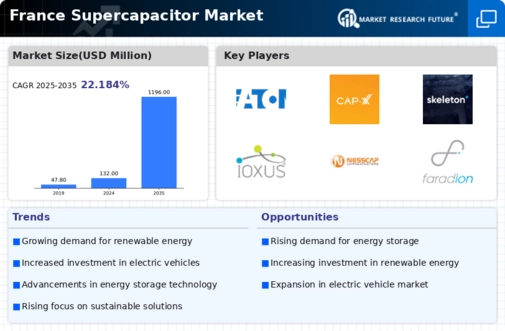Renewable Energy Integration
The integration of renewable energy sources, such as solar and wind, into the energy grid is becoming increasingly important in France. This shift necessitates advanced energy storage solutions to manage the intermittent nature of renewable energy generation. Super capacitors offer a viable solution due to their rapid charge and discharge capabilities, making them ideal for stabilizing the grid. In 2025, the French government aims to increase the share of renewables in the energy mix to 40%, which could potentially drive the demand for super capacitors significantly. The super capacitor market is likely to benefit from this trend as utilities and energy providers seek efficient storage solutions to enhance grid reliability and support the transition to a low-carbon economy.
Growing Electric Vehicle Adoption
The increasing adoption of electric vehicles (EVs) in France is a pivotal driver for the super capacitor market. As the automotive industry shifts towards sustainable energy solutions, super capacitors are gaining traction due to their ability to provide rapid energy discharge and recharge capabilities. In 2025, the EV market in France is projected to grow by approximately 30%, leading to heightened demand for efficient energy storage systems. Super capacitors, with their long cycle life and high power density, are particularly suited for applications in hybrid and fully electric vehicles. This trend indicates a significant opportunity for manufacturers in the super capacitor market to cater to the evolving needs of the automotive sector, thereby enhancing their market presence and driving innovation in energy storage technologies.
Growing Demand for Consumer Electronics
The rising demand for consumer electronics in France is another significant driver for the super capacitor market. As devices become more compact and energy-efficient, the need for reliable and efficient energy storage solutions is paramount. Super capacitors are increasingly being utilized in portable electronics, such as smartphones and wearables, due to their rapid charging capabilities and long cycle life. In 2025, the consumer electronics market in France is projected to grow by 15%, which could lead to a corresponding increase in demand for super capacitors. This trend suggests that manufacturers in the super capacitor market may need to adapt their product offerings to meet the specific requirements of the consumer electronics sector, thereby expanding their market reach.
Advancements in Manufacturing Technologies
Recent advancements in manufacturing technologies are poised to enhance the production efficiency of super capacitors in France. Innovations such as automated production lines and improved materials are likely to reduce production costs and increase output quality. This could lead to a more competitive landscape within the super capacitor market, as manufacturers strive to meet the growing demand from various sectors, including automotive and renewable energy. Furthermore, the potential for cost reductions may enable wider adoption of super capacitors in consumer electronics and industrial applications. As production techniques evolve, the super capacitor market may witness a surge in new entrants, fostering innovation and driving down prices for end-users.
Increased Investment in Research and Development
Investment in research and development (R&D) within the super capacitor market is crucial for driving innovation and enhancing product performance. In France, both public and private sectors are recognizing the importance of R&D in developing advanced energy storage solutions. Increased funding for R&D initiatives is expected to lead to breakthroughs in super capacitor technology, such as improved energy density and longer lifespan. As of 2025, it is estimated that R&D spending in the energy storage sector could reach €500 million, indicating a strong commitment to advancing super capacitor technologies. This focus on innovation may position France as a leader in the super capacitor market, attracting further investment and fostering collaboration between academia and industry.

















Leave a Comment